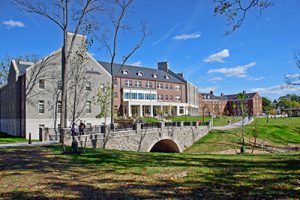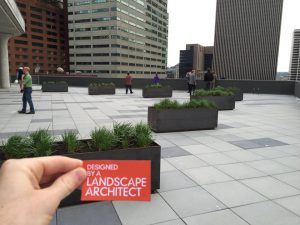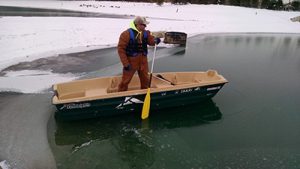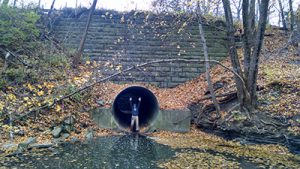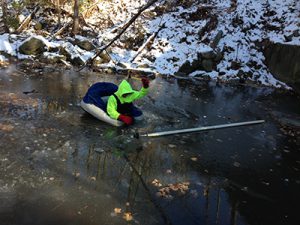Landscape Architecture Month: Designing a Better Community
April is World Landscape Architecture Month — a time dedicated to promoting landscape architecture to students and educating others about what it means to be a landscape architect.
Landscape architects are the people responsible for designing the parks, plazas, streetscapes, and green spaces that make the outdoors healthy, sustainable and enjoyable. At the Kleingers Group, we are proud of the role our landscape architects play in moving communities forward.
This month, we asked our landscape architects about why their profession is important, why they got involved, and what projects count among their favorites.
1. Why Are Landscape Architects Important?
“Landscape architects are important because they have the ability and skills to bring many different people and professions together to create improvements for the community. LA’s look at projects from a holistic approach, searching for the best solution.” – Michael
“Without landscape architects our world would be boring! Landscape architecture is not just about making things look pretty, its about creating and transforming spaces that initiate lifestyles and allow users to get outside and enjoy quality designed spaces. Landscape architects shape our built environment, they create spaces that function but are also aesthetically pleasing and designed to enhance the user’s quality of life.” – Ryan
2. What Inspired You to Become a Landscape Architect?
“I was inspired to enter the profession of landscape architecture when my parents decided it was time to spruce up their house. I was in middle school when they hired a landscape architect to completely transform their outdoor spaces. I immediately became interested in the process from reviewing plans, to choosing materials, to looking at plants. It wasn’t until I saw the finished product and the amazing transformation happen that I knew I wanted to do this for the rest of my life. After the transformation, the way we used our outdoor spaces changed. We no longer used the inside of our house for the majority of our activities, my family was outside as much as possible enjoying the amazing spaces that were created. I knew I wanted to design these spaces so everyone could have as much fun enjoying nature as I have.” – Ryan
“I first learned about the profession of landscape architecture from my dad, as he had graduated from Ohio State with a degree in Landscape Architecture. From listening to him talk about the profession, I knew that there was a lot more to landscape architecture than just designing planting plans. It was interesting to hear his stories about happenings that had occurred in the studio while drawing or something that happened in the field. It all sounded exciting. Because my dad graduated in landscape architecture from Ohio State, I remember seeing an alumni brochure he received in the mail showing the landscape architecture studio space. That sealed the deal for me, I thought it would be really cool to work in a creative studio environment.” – Lynne
“My senior year of undergrad, I took an environmental design class where I learned about landscape architecture for the first time. It combined many of my interests of design, the outdoors, etc. and the rest is history.” – Michael
3. Do You Have a Favorite Project that You Have Worked On?
“My favorite project I worked on was the Japanese American National Museum project in Los Angeles. It is my favorite project because it was the first project I worked on from concept design all the way through construction administration. I also loved the design of the project as well as the scale. It was also fun because George Takei, Sulu, from Star Trek was on the board of trustees of the Japanese American National Museum. I remember him being at a couple of meetings. I never watched Star Trek, so, I didn’t really care, but, it was funny to come back to the office and everyone would ask if George was at the meeting because they were Star Trek fans. The project also incorporated a fountain designed by Robert Murase.” – Lynne
“One of my favorite projects is one of my earliest ones that I did while working with LDR/HNTB in Maryland, called Carroll Creek. It transformed a desolate flood control infrastructure into an urban park, generating new business and residences for the city of Frederick, MD.” – Michael
“My favorite project I have worked on would be Miami University’s Western Campus. It was a large project with many different aspects. This project was a fast-paced project that allowed me to express a lot of creative freedom. Because the project was so fast paced, I was able to see how the design translated from paper to a real life application while the design was still fresh in my mind, which is pretty rare in our profession. Also, most my family members went to Miami University, so when we go up to oxford it also allows me take them to the project and brag about how cool the finished product is!” -Ryan
4. What Is Your Favorite Part of The Job?
“My favorite part of being a LA is seeing the physical impact on the community that our designs/projects have. To go to a public project (or a private one) and see people using it is the best reward.” – Michael
“I really enjoy most aspects of the profession because it is ever changing. I would say my absolute favorite portion would be the creative freedom we, as designers, are allowed. No two projects are alike, so it allows us to create unique new spaces with each project. The job is never monotonous and always keeps you interested and on your toes!” – Ryan
5. What Have You Done to Educate Others About the Profession?
“I serve as the Ohio Chapter VP of ASLA and therefore, I am working with our state legislators on advocacy for the profession. In fact, next week, I go to Washington D.C. to speak to our senators and representatives about issues relative to the landscape architecture profession. I have visited a class of kindergarteners and talked to them about landscape architecture and what we do as professionals. To show them in a way that they can relate, I asked them what they liked about parks and wrote down the list of things they liked to do at parks. Then, in a charrette style, right in front of them, I designed a park with all the elements they love. While doing so, I opened up their eyes that not only do landscape architects think about the fun stuff in a park, such as the playstructures, but also plan how the overall park is master planned and designed. For example, how you get to a park, (driving, walking or riding your bike), restroom facilities, parking areas, shade, and seating etc. and how all these elements work together.” – Lynne
“It is a constant education to explain to people that LA’s do more than backyards, golf courses or plants. To help get that message out there, I have spoken at conferences, public meetings, and just converse with people in general.” – Michael
With Kleingers’ Help, Deer Park Vision Plan Wins Award
Congratulations to Jay Stewart and Tim Casto for their work on the Deer Park 2035 Vision Plan, which recently won the Frank F. Ferris II Planning Award in the Implementation category! The award honors local communities whose efforts have contributed to the elevation of planning principles, greater awareness of the value of planning and improved quality of life.
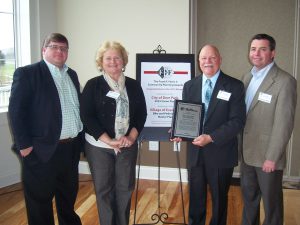 The Kleingers Group drafted the Vision Plan with a heavy emphasis on the implementation of the key priority action items. Some of the key action items identified in the plan and implemented since the plan’s adoption in 2008 include:
The Kleingers Group drafted the Vision Plan with a heavy emphasis on the implementation of the key priority action items. Some of the key action items identified in the plan and implemented since the plan’s adoption in 2008 include:
- Update of the City Zoning Code – Following on the heels of adopting the Vision Plan, the City’s first implementation project involved the re-write of the City Zoning Code.
- Blue Ash Road Streetscape Project – With the help of the City’s planning consultant,The Kleingers Group, the OKI Regional Council of Governments; Ohio Department of Transportation; and Hamilton County Engineers, funding has been secured for the $6.5 million Blue Ash Road improvement project.
- Development of a Capital Improvement Plan – Acting on one of the key recommendations from the Vision Plan, Deer Park created and adopted its first Capital Improvement Plan.
- Creation of a Community Reinvestment Area (CRA) Tax Incentive Program – In September 2012, the Deer Park Council designated the entire City as a Community Reinvestment Area (CRA) to provide tax incentives to property owners to encourage new investment.
- Creation of a Community Improvement Corporation (CIC) – Created in February 2011, the Deer Park Community Improvement Corporation (CIC) serves as the economic development arm of the City.
- Establishment of the Deer Park Business Organization – Beginning in 2009, the City spearheaded the creation of the Deer Park Business Association (DPBA).
The 2035 Vision Plan recognized that without a written master plan, the City of Deer Park would likely place itself at a disadvantage when presented with redevelopment and other growth related opportunities. The implementation of the Vision Plan’s priority goals and action steps will facilitate fiscal sustainability, maintain and enhance the quality of life for residents and businesses, preserve the City’s many traditional neighborhoods, and place Deer Park in a competitive position in the Greater Cincinnati economy.
Tim Casto, serves as Deer Park’s City Engineer. Jay Stewart, serves as a planning consultant to the city and is President of the Deer Park Community Improvement Corporation.
Survey Week: Building Better Communities
The Kleingers Group has long believed in the importance of building better communities.
While we hope that those values come through on every project we work on, there are some projects of which we are particularly proud.
For the last several years, The Kleingers Group has worked with Habitat for Humanity Greater Cincinnati to survey properties donated to the group.
Specifically, once an individual has donated a piece of property to Habitat, our surveyors have volunteered to complete boundary and topographic surveys of the property, ensuring property lines are correct and no conflicts exist with the property.
Habitat then uses the information to build a new home or rehabilitate an existing home.
“This is one thing we can do to help the overall community by giving back,” said Director of Surveying Dave Cox.
This past year, surveyors have spent time at homes in Lockland, but have previously surveyed throughout the Greater Cincinnati area.
In addition to the time spent surveying, our surveyors have also given to their communities in a multitude of other ways, helping others to learn about the profession.
Several of our surveyors have spent time helping Cub Scouts earn their Engineering badges by helping them learn about what engineers, architects, and surveyors do.
Recently, Matt Habedank worked with the St. Dominic cub scout pack 483, showing them how to measure property lines with the robotic total station.
Among other things, Matt said he let the kids guess how far they were away from the instrument.
Most of them have never even heard of surveying, Matt said, and learning about it can be eye-opening.
Other surveyors have volunteered their engineering knowledge throughout the world. Randy has spent time on construction projects in Guatemala, Ecuador, and Peru.
Regardless of how they choose to do it, The Kleingers Group is proud of our surveyors for helping to strengthen their communities and for sharing their knowledge and talents.
National Surveyors Week
This week marks National Surveyors Week! Our 25 registered surveyors and technicians are a hardy bunch and have braved conditions ranging from freezing, sweltering, wet, muddy, buggy, smelly, claustrophobic, and itchy all in the name of accurate surveys and maps. This week we salute them!
This week is also about promoting the profession and educating others. With that in mind, we asked our surveyors about some of their favorite experiences.
1. how Do You Explain to Someone (who Knows Nothing About Survey) What It Is that You Do?
“We stand behind a ‘camera’ and take pictures!! 😉 We do such a multitude of things its often hard to describe, but mostly we give engineers a basis to begin their design by locating terrain and physical features and producing a drawing or map that they use to design with. As one of my former colleagues said “if it wasn’t for all the math and walking it would be pretty good job!” – Adam C.
“If I am talking to one of my friends about my job, I tell them I draw up plans of an area we surveyed or gather information of the owners of that lands we are doing work on.” – Adam I.
2. What Is the Weirdest Thing You Have Ever Surveyed/Scanned?
“I spent a lot of time at Rumpke landfill doing a multitude of surveying activities. Many times, they had us getting the height of the trash to make sure they weren’t going over the height allowed by the county. Other times they had us surveying existing and proposed gas lines as they would sell off the gas being produced underneath the trash.” – Randy
“While working for a company as a CO-OP, we had to survey a lime bed field with a ‘sled’ that had three prisms on it, which two people pulled back and forth along the bed.” – Adam I.
“We scanned the inside of a manhole (just last week) by lowering the scanner down the hole using a winch/tripod system that was designed and made by a couple of our former employees. I also staked grave markers at a cemetery one time, which was a little weird.” – Adam C.
3. What Is the Coolest Project You Have Ever Done?
“The coolest project that I worked on would have to be working on the Rockies Express Pipeline for three months in the field and about a month in the office.” – Adam I.
“While everything we do is ‘cool’, I remember on one occasion working in the field I had to get on a boat that took me out to a barge in the middle of the Ohio River. Once on the barge, I climbed up on the top of a pylon they had attached to a crane. The crane swung me out over the water and I had to have our instrument man on the shore line me up with where the pier needed to go so they could drive it into the bottom of the Ohio. These series of piers were being set for a conveyor system to load coal from the shore directly onto the barges.” – Randy
“I’m not sure what the ‘coolest’ would be but, I enjoy working on higher profile projects that require special attention to detail or creative solutions (Fountain Square, Dunnhumby, Cincinnati Premium Outlets come to mind – I’m sure there are others)” – Adam C.
4. What Is Your Favorite Part About Your Job?
“I guess it’s working with our surveying staff. We have a great group of surveyors who are tremendously talented and experienced, and have great attitudes. They care deeply about how we do things, and about TKG, which makes my job a whole lot easier! It’s cool to be able to see projects completed and know that you played a part in the process of building the project.” – Adam C.
“My favorite part of my job would be the variety of work that I could be doing from day to day. One day in might be doing research at the courthouse or I could be mapping up a topographic survey for a large site.” – Adam I.
“I like that every job brings different challenges to think about and find solutions too.” – Randy
5. What Have You Done to Educate Students or Others About the Profession?
“I spent four years teaching survey calculations at Cincinnati State. I also worked with a local Boy Scout troop on survey equipment and maps.” – Randy
“I’ve worked with students at Cincinnati State conducting mock interviews to help them with job and co-op searches.” – Adam C.
6. Have You Participated in Any Volunteer Work Related to Survey?
“While not 100 percent survey related, but rather more engineering, I have been involved in a several construction projects in Guatemala, Ecuador, and Peru (houses, churches, and schools).” – Randy
“We have completed several Boundary/Topographic and plot plan projects for Cincinnati Habitat for Humanity over the past several years. They are fairly “standard” surveying projects that we do pro bono to help out the greater community.” – Adam C.
